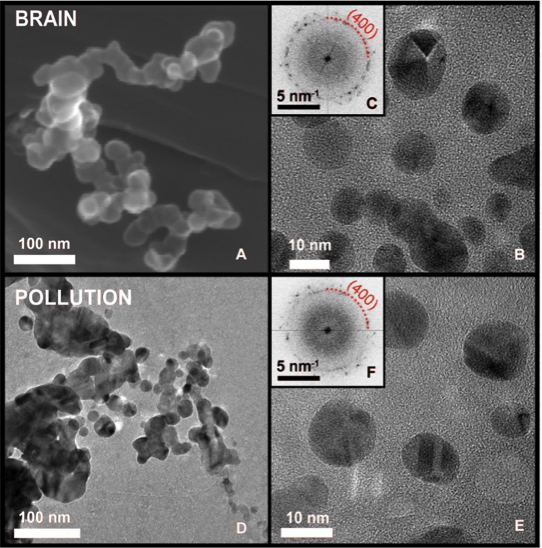Toxic air pollution nanoparticles discovered in the human brain
Published: 6 September 2016
Magnetic nanoparticles from air pollution have for the first time been discovered to have accumulated in human brains.
 Magnetic nanoparticles from air pollution have for the first time been discovered to have accumulated in human brains. The discovery is important because the nanoparticles are known to be chemically active and may be implicated in neurodegenerative conditions including Alzheimer's disease.
Magnetic nanoparticles from air pollution have for the first time been discovered to have accumulated in human brains. The discovery is important because the nanoparticles are known to be chemically active and may be implicated in neurodegenerative conditions including Alzheimer's disease.
Electron microscopy studies undertaken by Dr Donald MacLaren of the MCMP group identified magnetite nanoparticles in the brain tissue from 37 individuals aged three to 92-years-old who lived in Mexico City and Manchester. This strongly magnetic mineral is toxic and has been implicated in the production of reactive oxygen species (free radicals) in the human brain.
The study was led by Professor Barbara Maher, from Lancaster University, and was a collaboration between the Universities of Lancaster, Oxford, Glasgow and Manchester, in addition to the Universidad Nacional Autonoma de Mexico and The University of Montana.
Brain tissues collected from Mexico City and Manchester were prepared in Lancaster and analysed by electron microscopy in Glasgow. Unlike angular magnetite particles that are believed to form naturally within the brain, most of the observed particles were spherical, with diameters up to 150 nm, and had fused surfaces characteristic of high-temperature formation – such as from vehicle (particularly diesel) engines or open fires. The spherical particles are often accompanied by nanoparticles containing other metals, such as platinum, nickel, and cobalt.
Professor Maher said: “The particles we found are strikingly similar to the magnetite nanospheres that are abundant in the airborne pollution found in urban settings, especially next to busy roads, and which are formed by combustion or frictional heating from vehicle engines or brakes.”
Other sources of magnetite nanoparticles include open fires and poorly sealed stoves within homes. Particles smaller than 200 nm are small enough to enter the brain directly through the olfactory nerve after breathing air pollution through the nose.
“Our results indicate that magnetite nanoparticles in the atmosphere can enter the human brain, where they might pose a risk to human health, including conditions such as Alzheimer’s disease.” added Professor Maher.
Leading Alzheimer’s researcher Professor David Allsop, a co-author of the study from Lancaster University, said: “This finding opens up a whole new avenue for research into a possible environmental risk factor for a range of different brain diseases”.
The results have been published in the paper ‘Magnetite pollution nanoparticles in the human brain’ in the Proceedings of the National Academy of Sciences and also reported by the BBC (and BBC online), the Guardian and New Scientist magazine.
First published: 6 September 2016
<< News

